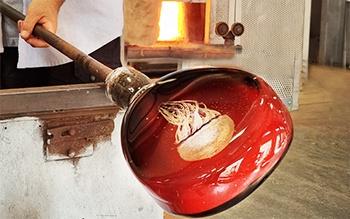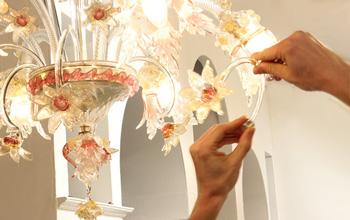From the beginnings, more than two millennia ago...
Considered one of the oldest processing techniques, dating back to Middle Eastern origins at least 300 BC, the glassblowing in the furnace, or Soffiato all’impronta or Soffio libero, is certainly one of the cornerstones of the Murano art tradition. Glasses, jars, goblets, chandeliers, sculptures, luxury bottles and more: the range of objects that can be realized through these careful passages older than two thousand years is vast and varied in shapes and colors.
Masters' expertise is crucial to the correct execution of the work, and their imagination in understanding and reinterpreting methods and procedures is fundamental to infusing added value to a handmade product, always unique and unrepeatable.
... to the wonder of today (in five key steps)
Here, then, is an ancient knowledge echoed through distant times and lands until reaching the lagoon of Venice, and particularly the island of Murano. A magic that can be described step by step:
1) The starting point is the same for all of them: a long metallic cable hose is inserted into the oven, where molten glass reaches temperatures around 1370 degrees, and, by rotary motion, this hose collects a more or less spherical mass on one end.
2) At this point, the process can vary, depending on the size and the specific features of the developing object: after a first modeling phase, it may be necessary to reinsert the metal barrel into the crucible to collect more glass; to insert the glass mass into a temperature crucible to keep it malleable; or to make it interact with other colored fused glass compounds to obtain a sphere with those chemical elements that, once processed and cooled, will generate those almost unlimited color combinations for which the Murano tradition is famous in the world.
3) Referring to the realization of goti, colorful glasses with shadowing nuances, an authentic classic of Murano's artistic production, the incandescent agglomerate is rubbed on a bed of glass powder of previously selected colors.
4) Analogous operation is then carried out on a surface of murrine, small sections of glass rods that have internally imaginative geometric decorations. At that point, the most delicate moment: blowing inside the cable metal instrument the glass mass is molded until it takes the desired cable spherical shape, a glass rod called puntello is attached to the convex side of it and, with great attention, the work that is being created from is separated from the metal support used for blowing.
5) The section just disconnected (which will become the top of the chalice) is heated and with quick touches of borselle, the iron pliers used for modeling, the spherical mass blown is opened in order to become the " mouth "of the goto. Once the puntello is disconnected from the bottom of what is now a fully recognizable chalice, the work in front of the eyes is the enchantment of a gesture handed down from generation to generation, century to century, in the continuity of an island such as Murano that also today can only leave amazed visitors and experts from all over the world.











